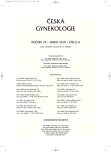-
Medical journals
- Career
Measurement of bone mineral density by heel ultrasound and forearm DXA in clinical practice
Authors: Tomáš Fait; J. Živný
Authors‘ workplace: Gynekologicko porodnická klinika 1. LF UK a VFN, Praha, přednosta prof. MUDr. A. Martan, DrSc.
Published in: Ceska Gynekol 2010; 75(4): 340-344
Overview
Objective:
The comparation of two possibilities of bone mineral density measurement – ultrasound and dual energy x-ray absorptiometry.Design:
Open nonrandomized observation study.Setting:
Department of Obstetrics and Gynecology, 1st Faculty of Medicine Charles University and General Faculty Hospital Prague.Methods:
We examined 190 women with mean age 56 years by both methods - Lunar PIXI (dual energy x-ray absorptiometry) on forearm and CUBA Clinical (broadband ultrasound attenuation) on heel. We took personal history for menopause status, hormone replacement therapy, smoking, sport activity and age.Results:
The incidence of T-scores was the same for both methods, there were differences in Z-scores. In both methods we have seen the same tendencies of interaction with risk factors. Bone mineral density (BMD) respective T-score significantly decreased with age. There were no significant connections between BMD and body mass index (lineary regression test), hormone replacement therapy (paired t-test), smoking and physical exercise (Mann-Whitney U test). T-score was significantly (p<0.003) lower in women with history of fracture (Mann-Whitney U test).Conclusion:
In spite of totally different principles of measurement both methods are able to screen BMD.Key words:
bone mineral density, osteoporosis, ultrasound, dual energy x-ray absorptiometry.
Sources
1. Albanesse, CV., Cepollaro, C., de Terlizzi, F., et al. Performance of five phalangeal QUS parameters in the evaluation of gonadal-status, age and vertebral fracture risk compared with DXA. Ultrasound Med Biol 2009, 35, 4, p. 537-544.
2. Collinge, CA., Lebus, G., Gardner, MJ., Gehring, L. A comparison of quantitative ultrasound of the calcaneus with dual-energy x-ray absoptiometry in hospitalized orthopaedic trauma patients. J Orthop Trauma 2010, 24, 3, p. 176-180.
3. Faulkner, KG., von Stetten, E., Steiger, P., et al. Discrepancies in osteoporosis prevalence at diferent skeletal sites: impact on the WHO criteria. Bone 1998, 23, p. 194.
4. Jensen, NC., Madsen, LP., Linde, F. Topographical distribution of trabecular bone strenght in the human os calcanei. J Biomchanics 1991, 24, p. 49-55.
5. Kanis, JA.Assesment of fracture risk and its application to screening for menopausal osteoporosis: synopsis of a WHO report. Osteop Int 1994, 4, p. 368-381.
6. Knapp, KM. Quantitative ultrasound and bone health. Salud Publica Mex 2009, 51, Suppl 1, S18-S24.
7. Michalská, D., Zikán, V., Štěpán, J. a kol. Rentgenová denzitometrie a ultrasonometrie patní kosti – přesnost a srovnání s denzitometrií osového skeletu. Čas Lék Čes 2000, 139, 8, s. 231‑236.
8. NAMS. Management of osteoporosis in postmenopauzal women: 2010 Statement position statement of the NAMS. Menopause 2010, 17, 1, p. 25-54.
9. Rosa, J. Léčba primární postmenopauzální osteoporózy, s. 133‑149. In: Fait, T., Dvořák V., Skřivánek J. a kol. Almanach ambulantní gynekologie. Praha: Maxdorf Jessenius 2009, 284 s.
10. Schwartz, DA., Connolley, CD., Koyama, T., et al. Calcaneal ultrasound bone densitometry is not a useful tool to screen patients with inflammatory bowel disease at high risk for metabolic bone disease. Inflamm Bowel Dis 2005, 11, 8, p. 749‑754.
11. Wahner, HW., Fogelman, L., Blake, GM., et al. The evaluation of osteoporosis. London: Martin Dunitz 1999, p.185.
Labels
Paediatric gynaecology Gynaecology and obstetrics Reproduction medicine
Article was published inCzech Gynaecology

2010 Issue 4-
All articles in this issue
- Ethics in neonatal intensive care
- Shoulder dystocia during vaginal delivery
- Analysis of cell free fetal DNA fragmentation rate in pregnant women during the course of gravidit
- DNA analysis on Y chromosomal AZF region deletions in Slovak population
- Guideline for prevention of RhD alloimmunization in RhD negative women
- Pregnant women alloimmunisation of non-RhD erythrocyte antigens: review article
- Perinatal brachial plexus palsy
- Repair of the 3rd and 4th degree obstetric perineal tear
- Severe obstetrical injuries and anal incontinence
-
Rekombinantní aktivovaný faktor VII (rFVIIa) v léčbě závažného poporodního krvácení
Data z registru UniSeven v České republice -
Trombotická trombocytopenická purpura v těhotenství
Kazuistika - Uterine rupture in pregnancy - case study
- Local sperm antibodies and general levels of immunoglobulins in ovulatory cervical mucus
- Measurement of bone mineral density by heel ultrasound and forearm DXA in clinical practice
- Complications of radical oncogynecological operations
- Process of women’s reproductive ageing – causes, evaluation and possible clinical usage
- Czech Gynaecology
- Journal archive
- Current issue
- Online only
- About the journal
Most read in this issue- Shoulder dystocia during vaginal delivery
- Repair of the 3rd and 4th degree obstetric perineal tear
- Perinatal brachial plexus palsy
- Complications of radical oncogynecological operations
Login#ADS_BOTTOM_SCRIPTS#Forgotten passwordEnter the email address that you registered with. We will send you instructions on how to set a new password.
- Career

